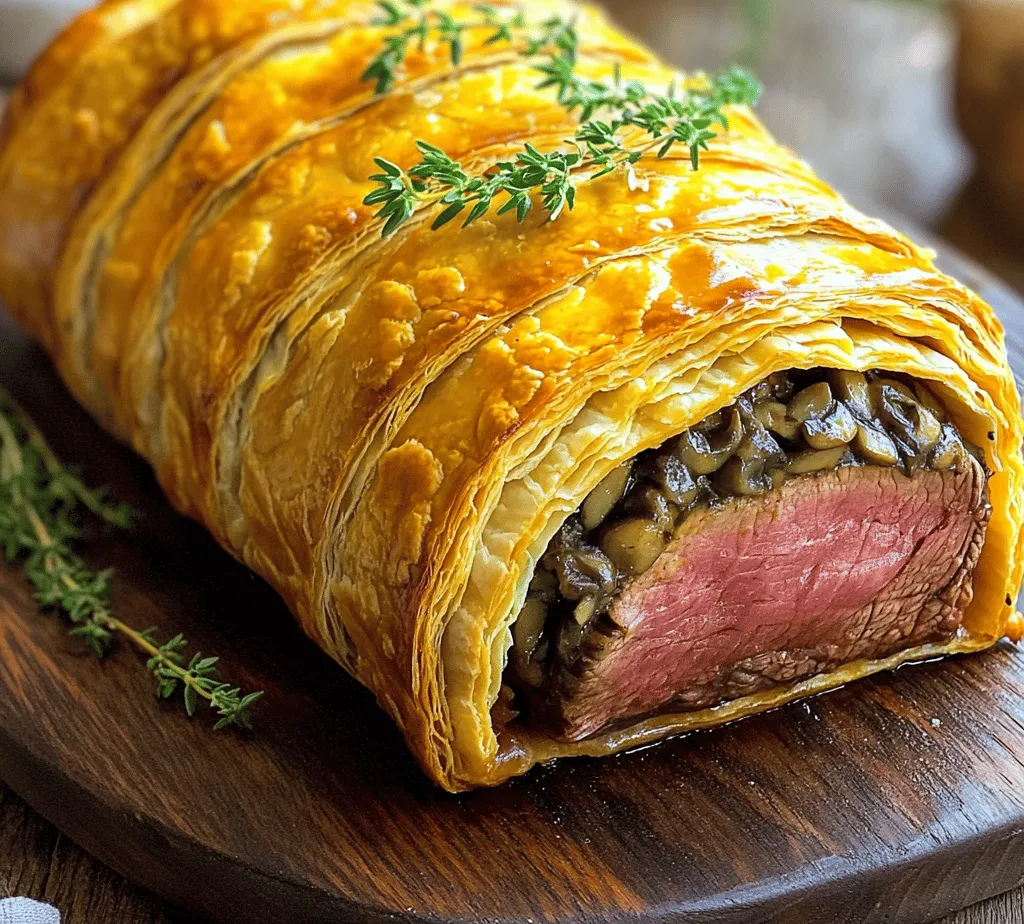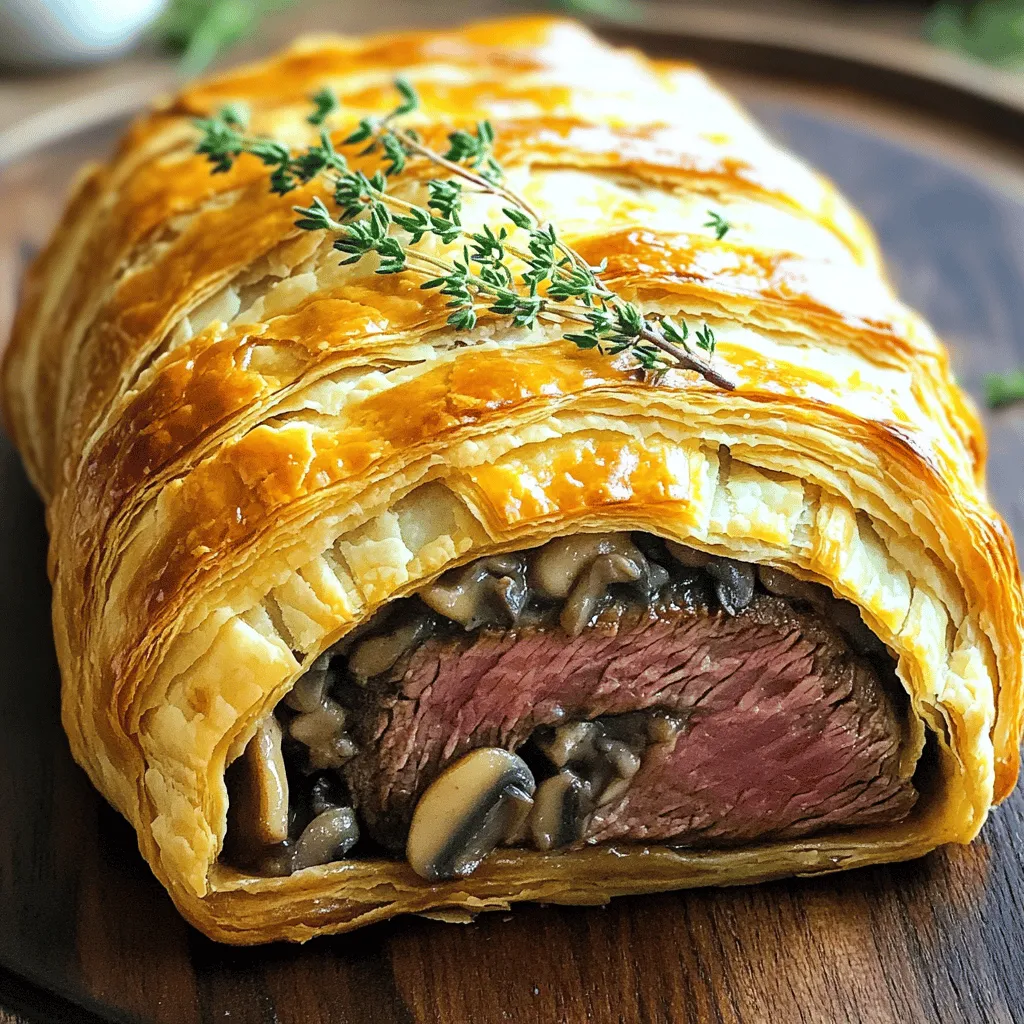Introduction
Beef Wellington is not just a dish; it’s an iconic culinary creation that exudes sophistication and elegance, making it a perfect centerpiece for special occasions. This classic recipe has captured the hearts of food enthusiasts and home cooks alike, often adorning the tables of festive gatherings and celebrations. With its rich flavors and stunning presentation, Beef Wellington is the epitome of fine dining at home, sure to impress your guests and elevate any dinner party.
The allure of Beef Wellington lies in its harmonious combination of quality ingredients and meticulous cooking techniques. The dish features a succulent beef tenderloin, enveloped in a flavorful mushroom duxelles, wrapped in delicate prosciutto, and finally encased in a golden puff pastry. Each layer contributes to a symphony of textures and tastes, creating a truly unforgettable dining experience.
In this article, we will guide you through the intricacies of preparing an exquisite Beef Wellington that will not only satisfy your taste buds but also leave your guests in awe of your culinary prowess. Let’s delve into the history of this classic dish, explore its key components, and gather all the essential ingredients you’ll need for this sophisticated dinner option.
Understanding Beef Wellington
The origins of Beef Wellington are somewhat debated, with various theories surrounding its inception. Some culinary historians trace its roots back to the early 19th century in England, possibly named after the Duke of Wellington, who led British forces to victory at the Battle of Waterloo. Others suggest that the dish may have been inspired by the French “bœuf en croûte,” which translates to beef in pastry. Regardless of its origins, Beef Wellington has become a staple in fine dining and is often associated with celebration and luxury.
Culturally, Beef Wellington holds a significant place in the realm of gourmet cuisine. It represents the art of cooking, where precision and skill are paramount. The dish has been featured in numerous cooking competitions and culinary shows, often regarded as a benchmark for aspiring chefs. Its presence on a menu signifies a commitment to quality and an appreciation for traditional cooking methods.
The beauty of Beef Wellington lies in its layered composition. At its core is a tender and juicy beef tenderloin, which is the most sought-after cut due to its tenderness and rich flavor. This is complemented by a mushroom duxelles—a finely chopped mixture of mushrooms, shallots, and herbs sautéed to perfection. The addition of prosciutto not only enhances the flavor but also adds a luxurious texture. Finally, the entire ensemble is enveloped in a flaky puff pastry that crisps beautifully during baking, creating a stunning visual appeal.
Key Ingredients for the Perfect Beef Wellington
To achieve a truly remarkable Beef Wellington, it’s essential to focus on high-quality ingredients. Each component plays a crucial role in the overall flavor and texture of the dish. Here’s a breakdown of the key ingredients that make up this culinary masterpiece:
Beef Tenderloin
The star of the show is undoubtedly the beef tenderloin. This cut is prized for its tenderness and rich flavor, making it the ideal choice for Beef Wellington. When selecting your beef, look for a well-marbled tenderloin, as the fat content contributes to the juiciness and flavor. It’s advisable to use a whole tenderloin, which you can trim and prepare yourself for the freshest result. This cut is best cooked to medium-rare, allowing its natural flavors to shine.
Olive Oil
Olive oil plays a vital role in enhancing the flavors of the dish while also facilitating the cooking process. It is used to sear the beef tenderloin, creating a beautiful crust that locks in moisture and flavor. Opt for a high-quality extra virgin olive oil for the best taste. Its fruitiness will complement the richness of the beef and the earthiness of the mushrooms.
Cremini Mushrooms
Mushroom duxelles is a key component of Beef Wellington, and cremini mushrooms are an excellent choice for this preparation. Their deep, earthy flavor adds complexity to the dish. Proper moisture control is vital when preparing the duxelles; overcooked mushrooms can release excess moisture, which may result in a soggy pastry. Aim to finely chop the mushrooms and sauté them until they release their liquid and become dry and concentrated in flavor.
Garlic and Thyme
Garlic and thyme are essential aromatics that contribute significantly to the overall taste profile of the dish. Garlic adds depth and richness, while fresh thyme provides a fragrant herbal note that complements the beef and mushrooms beautifully. Use freshly chopped thyme for the best flavor, as dried thyme can be more potent and may overpower the dish.
Prosciutto
The addition of prosciutto not only enhances the flavor but also contributes to the texture of the Beef Wellington. This Italian dry-cured ham adds a savory note and helps to keep the beef moist during cooking. When wrapping the tenderloin, the prosciutto acts as a barrier, preventing moisture loss while imparting its rich flavor. Look for thinly sliced, high-quality prosciutto for the best results.
Dijon Mustard
Dijon mustard serves as both a flavor enhancer and a moisture-retaining agent in Beef Wellington. A thin layer spread over the beef tenderloin adds a tangy depth that elevates the overall taste. Additionally, the mustard helps to create a barrier that prevents the pastry from becoming soggy. Choose a smooth, stone-ground Dijon for a balanced flavor.
Puff Pastry
The final touch that brings the dish together is the puff pastry. This flaky pastry adds a beautiful texture and structure to the Beef Wellington. When baking, the pastry puffs up, creating a golden-brown crust that encases the flavorful filling. You can either make your own puff pastry or opt for high-quality store-bought pastry to save time. Ensure the pastry is chilled before use, as this will help achieve a better rise during baking.
Sourcing High-Quality Ingredients
For the best results, sourcing high-quality ingredients is paramount. Visit local butcher shops for the best cuts of beef, and consider purchasing organic or grass-fed options for superior flavor. Fresh produce markets are an excellent place to find seasonal mushrooms, garlic, and herbs. When it comes to prosciutto and puff pastry, specialty grocery stores or gourmet markets often carry premium brands that will enhance your dish.
With all these components at your disposal, you are now ready to embark on the journey of creating a stunning Beef Wellington that is sure to impress. The next steps will guide you through the process of assembling and cooking this pièce de résistance, ensuring that your culinary creation is a delicious success.
Step-by-Step Instructions for Making Beef Wellington
Now that you have a comprehensive understanding of the ingredients and their roles in the Beef Wellington, it’s time to dive into the preparation process. Follow these detailed steps to create an exquisite Beef Wellington that will have your guests raving about your culinary skills.
1. Prepare the Beef Tenderloin: Start by trimming any excess fat and silverskin from the beef tenderloin. Season generously with salt and pepper on all sides.
2. Sear the Beef: In a hot skillet, add olive oil and sear the tenderloin for about 2-3 minutes on each side until it forms a golden-brown crust. Once seared, remove the beef from the skillet and let it rest.
3. Make the Mushroom Duxelles: In the same skillet, add finely chopped cremini mushrooms, minced garlic, and chopped thyme. Cook over medium heat, stirring frequently, until the mushrooms release their moisture and become dry. Season with salt and pepper to taste. Allow the duxelles to cool.
4. Assemble the Wellington: Lay out slices of prosciutto on a sheet of plastic wrap, slightly overlapping each slice. Spread a layer of the cooled mushroom duxelles over the prosciutto, then place the beef tenderloin on top. Use the plastic wrap to roll the prosciutto and mushrooms around the beef tightly. Twist the ends of the plastic wrap to secure the roll and refrigerate for about 15-30 minutes to set.
5. Prepare the Puff Pastry: Roll out the puff pastry on a floured surface to ensure it is large enough to encase the entire beef roll.
6. Coat the Beef: Remove the beef roll from the refrigerator and unwrap it. Brush the beef with a thin layer of Dijon mustard for added flavor.
7. Wrap the Beef in Pastry: Carefully place the beef roll onto the center of the puff pastry. Fold the pastry over the beef, sealing the edges by pinching them together. Trim any excess pastry and ensure there are no gaps.
8. Chill and Preheat: Place the wrapped Beef Wellington on a baking sheet lined with parchment paper. Chill in the refrigerator for another 15 minutes while you preheat your oven to the appropriate temperature.
With these initial steps, you’re well on your way to crafting a stunning Beef Wellington that will be the highlight of your dinner gathering. The careful attention to detail and quality ingredients will undoubtedly shine through in the final presentation and taste of this elegant dish. Stay tuned for the next part, where we will explore the finishing touches, cooking methods, and some expert tips to ensure your Beef Wellington is nothing short of perfection.

Preheat the Oven
Before you dive into the details of preparing your Beef Wellington, it’s crucial to preheat your oven. The ideal temperature for baking Beef Wellington is 400°F (200°C). Proper temperature control is essential for ensuring that the puff pastry achieves that golden, flaky texture while the beef cooks to perfection. An adequately heated oven allows the pastry to rise effectively, creating a beautiful crust that encases the savory filling. Be sure to give your oven ample time to reach the desired temperature before placing the Wellington inside.
Sear the Beef
Searing the beef is a pivotal step in achieving a perfectly cooked Beef Wellington. Begin by seasoning your beef tenderloin generously with salt and pepper. Heat a tablespoon of oil in a heavy skillet over medium-high heat until it shimmers. The goal here is to create a rich, brown crust on all sides of the beef, which not only enhances the flavor but also locks in juices.
When searing, avoid overcrowding the pan; if necessary, work in batches. Each side should be seared for about 2-3 minutes until a deep brown crust forms. Once seared, remove the beef from the skillet and let it cool slightly. This step is crucial because it prevents the beef from continuing to cook during the assembly phase, which could lead to overcooked meat once the Wellington is baked.
Prepare the Mushroom Duxelles
Next, you’ll need to prepare the mushroom duxelles, which is a finely chopped mushroom mixture that adds moisture and umami flavor to your Beef Wellington. Start by finely chopping your mushrooms, shallots, and garlic. You can use a food processor to achieve a uniform consistency quickly.
In a large skillet, melt a couple of tablespoons of butter over medium heat. Add your mushroom mixture and cook it down slowly, allowing all the moisture to evaporate. This process can take about 10-15 minutes, but patience is key. The goal is to achieve a dry mixture that intensifies in flavor without being soggy. Once the duxelles is thick and paste-like, season it with salt, pepper, and a touch of thyme or parsley to taste. Allow it to cool before assembly.
Wrapping with Prosciutto
Wrapping the beef with prosciutto is essential for adding richness and helping to keep the moisture in. Lay out slices of prosciutto on a sheet of plastic wrap, slightly overlapping them to create a uniform layer. Spread the cooled mushroom duxelles evenly over the prosciutto, ensuring coverage that matches the size of your beef tenderloin.
Carefully place the seared beef in the center of the prosciutto and mushroom mixture. Using the plastic wrap, lift one side of the wrap and roll it over the beef, tightly wrapping the prosciutto and mushroom around it. Keep rolling until the beef is completely encased. Twist the ends of the plastic wrap to secure, and place it in the refrigerator for about 15-20 minutes. This chilling will help the wrap hold its shape when you move on to the pastry stage.
Rolling Out the Pastry
Handling puff pastry can be tricky, but with the right techniques, you can achieve a flawless wrap. First, make sure your pastry is chilled but pliable. Dust your work surface with flour and roll out the pastry into a rectangle large enough to encase your beef entirely. Aim for a thickness of about 1/8 inch to ensure it bakes properly without becoming soggy.
Be gentle when rolling; if you notice any tears, patch them together with a bit of extra dough. Once rolled out, transfer it to a baking sheet lined with parchment paper. This will make the transfer easier once the beef is wrapped.
Wrapping the Beef
Now it’s time to wrap your beef in the pastry. Remove the plastic wrap from the beef and carefully place the wrapped beef in the center of the pastry. Fold the pastry over the beef, ensuring it is completely enclosed. Brush the edges with beaten egg to help seal them together, and trim any excess pastry.
To create steam vents, use a sharp knife to cut a few small slits on the top of the wrapped Wellington. This allows steam to escape during baking and prevents the pastry from getting soggy.
Baking Process
With your Beef Wellington assembled, it’s time to bake. Preheat the oven to 400°F (200°C) if you haven’t already. Bake the Wellington for approximately 25-30 minutes, or until the pastry is golden brown and the internal temperature of the beef reaches your desired doneness—125°F (52°C) for rare, 135°F (57°C) for medium-rare, or 145°F (63°C) for medium.
For the best results, use a meat thermometer to check the internal temperature. Once baked, remove the Wellington from the oven and let it rest for about 10-15 minutes. This resting period allows the juices to redistribute within the meat, ensuring each slice is juicy and tender.
Resting the Wellington
Resting your Beef Wellington is an essential step that many home cooks overlook. Allowing the Wellington to rest for 10-15 minutes after baking will keep the juices from spilling out when you slice into it. If you cut it too soon, all the delicious juices will run out, leaving you with dry meat. During this time, cover the Wellington loosely with aluminum foil to keep it warm.
Serving Suggestions and Presentation Tips
When it comes to slicing and serving your Beef Wellington, use a sharp knife for clean cuts. Aim for even portions, about 1-2 inches thick, to showcase the beautiful layers of pastry, prosciutto, mushroom duxelles, and tender beef.
For presentation, consider garnishing with fresh herbs, such as thyme or parsley, to add a pop of color. A drizzle of balsamic reduction can also enhance the visual appeal and add a touch of acidity to balance the richness of the dish.
In terms of side dishes, Beef Wellington pairs beautifully with sautéed seasonal vegetables, such as asparagus or green beans, and a fresh, crisp salad. For a more indulgent experience, consider serving creamy mashed potatoes or a rich potato gratin alongside. These sides not only complement the flavors of the Wellington but also add to the elegant dining experience.
To create a festive atmosphere, set the table with elegant dinnerware and soft lighting. Consider using candles or fairy lights to enhance the ambiance, making the meal feel even more special.
Nutritional Information
Beef Wellington is a rich dish, so understanding its nutritional profile can help you balance your meal. A typical serving of Beef Wellington (about 6 oz of beef with pastry) contains approximately:
- Calories: 600-700
- Protein: 45g
- Carbohydrates: 50g
- Fat: 35g
- Fiber: 2g
This nutritional breakdown can vary based on portion size and the specific ingredients used. To balance the richness of the Wellington, serve it with lighter sides, such as a mixed green salad or steamed vegetables, which can help round out the meal without overwhelming your palate.
Conclusion
Beef Wellington is more than just a dish; it’s a culinary masterpiece that embodies elegance and flavor. The combination of tender beef, savory mushroom duxelles, and flaky pastry results in a dining experience that is sure to impress your guests. Whether you’re hosting a holiday gathering, a special occasion, or a cozy dinner with loved ones, this classic recipe is a worthy centerpiece.
I encourage you to try your hand at making Beef Wellington for your next special occasion. While it may seem intimidating at first, the satisfaction of mastering this classic dish is immensely rewarding. Not only will you impress your friends and family, but you’ll also create unforgettable memories around the dinner table. So gather your ingredients, roll up your sleeves, and embark on this culinary adventure. Enjoy the process, and most importantly, savor every delicious bite!


